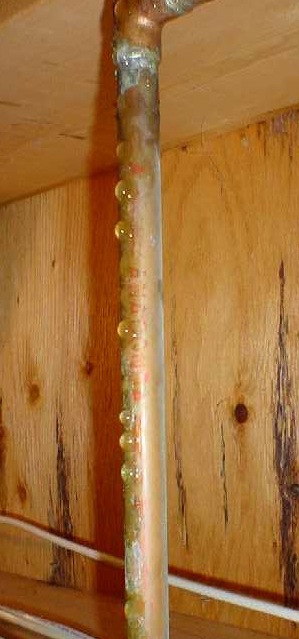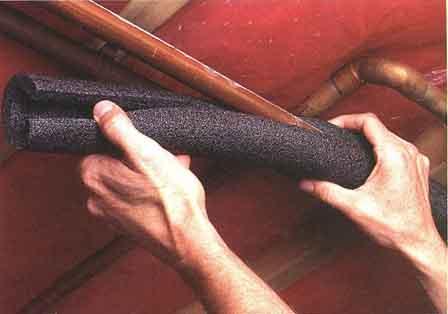Condensation, also called sweating, forms on building materials when the temperature drops below the dew point, which is the temperature at which droplets of water vapor are forced so closely together that they coalesce into liquid water. Because of their characteristic thermal conductivity, components made of metal are usually the first places where condensation will appear in a building. 
Condensation can be a problem because droplets can pool and destroy building materials, such as when condensed water chronically drains from a toilet and weakens the bathroom tile floor and subfloor. Condensation can also pool and encourage the growth of mold, which is a serious health hazard. Dripping overhead pipes can be an extreme annoyance in a finished basement, as they may damage carpets, furniture and valuable electronics. Pooled condensation can even cause an electrical fire, or electrocute building occupants.
Where does condensation typically form?
- plumbing drains. Condensation may collect on cast-iron or copper drain piping if a leaking plumbing fixture sends cold water through the building's drain piping system;
- cold water pipes. In humid environments, condensation will quickly form on water pipes that distribute cold water;
- water pressure tanks. Especially in colder or more humid climates, water pressure tanks may experience condensation when water is flowing at a high and steady rate;
- in windows, a topic which is covered at length in InterNACHI's article on condensation in double-paned windows; and
- plumbing fixtures that are in constant use or are defective and constantly refilling, especially toilets. Toilets commonly sweat in the summer due to high levels of humidity, unlike windows, which host condensate in the winter when the outside temperature is very low.
Metal that does not come into contact with cold water or air rarely exhibits excessive condensation, even though it's exposed to the same moisture-laden air as everything else around it. A water pipe that carries only warm water, for instance, seldom cools below the dew point. And non-metal building materials that do come into contact with cold water or air (such as plastic drains and piping) often lack the thermal conductivity to become cold enough to be the source of condensation. Metals also vary in their thermal conductivity. Thus, they tend to cause water vapor to condense. Inspectors can be aided by a rule of thumb that states that a metal's ability to transfer heat (and, therefore, create condensation) is roughly equal to that metal's electrical conductivity. Electricians and some inspectors may know that, of all metals, copper is the second-best conductor of heat and electricity, meaning that it's more likely to respond to a brief burst of cool water or air than other metals, such as steel or lead. The metal with the greatest conductivity is silver, but it's far too expensive to be used in ordinary construction.
Condensation is more of a problem in older homes, which often lack a vapor barrier or sealers in the concrete. In this instance, moisture in the ground is forced through the foundation and masonry, which is why condensation is commonly found in the basements of older buildings. The two strategies used to reduce condensation are to lower the relative humidity of the air and to keep surfaces from becoming cold. These strategies can be practiced in the following ways:
- Use a dehumidifier. This is a simple, effective appliance used to lower the humidity of the air, as it forces water vapor to condense into a water tank so it cannot condense elsewhere. An air conditioner can also dehumidify the air.
- Remove plants from the home. This will decrease relative humidity, as their transpiration of moisture is a significant source of water vapor in homes.
- Insulate cold surfaces. Insulation will keep surfaces from becoming cold, and it can easily be applied to water pipes and water pressure tanks. Fiberglass insulation should be avoided, as it's ineffective when wet and it can be the source of mold growth. Plastic foam wrap is an adequate material for this purpose. Keep in mind that by adding thermal insulation to water pipes, they can no longer be counted on to supply radiant heat to their surroundings.
- Ventilate the basement. However, this tactic might be counterproductive if the outside air is more humid than the indoor air.
- Add heat where condensation is a particular problem.
Also, keep in mind that what appears to be condensation may actually be a water leak. If insulation and dehumidification don't seem to improve the condensation problem -- especially if it's appearing in only one place -- homeowners should contact a qualified plumber. In summary, condensation will form on cold surfaces if certain precautions are not taken. If left unmitigated, it can lead to moisture-related problems that can affect structural components, as well as the occupants' health.

Comments(2)